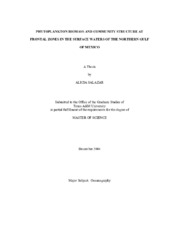| dc.description.abstract | Satellite images of chlorophyll concentration in the surface waters of the Gulf of
Mexico suggest a high degree of heterogeneity in the phytoplankton biomass. The
causes of this variability and the amount of variability in the phytoplankton community
structure are not well understood. The physical and chemical conditions of a specific
environment can influence phytoplankton community structure by selecting for those
phytoplankton species able to survive within that environment. Varying salinity and
temperature characteristics give water masses distinct surface water density signatures.
This study examined the relationship between phytoplankton biomass, community
structure, and different water mass properties by measuring chlorophyll a and algal
group concentration across frontal zones.
Continuous salinity and temperature measurements were used to calculate
continuous density along transects during four cruises on the R/V Gyre between
summer 2002 and spring 2004. Frontal zones were identified as areas of sharp density
change where σt changed by 1.5 points over a distance of 1 km. Density fronts that
coincided with visible temperature fronts (satellite AVHRR images) were selected for
biomass and community structure analysis. Discrete water samples were analyzed using
fluorometric analysis (total chlorophyll a concentration) and HPLC analysis
(photosynthetic pigments). Community composition for discrete samples was
determined using CHEMTAX and these values were used to interpolate community
composition.
Phytoplankton biomass and community structure were examined at a total of 21
density fronts. Unlike previous studies of frontal zones, phytoplankton biomass
(measured as chl a concentration) was not significantly higher within frontal zones than
in adjacent waters at any of the 21 fronts. Community composition (measured as algal
group abundance and diversity) was significantly different between the front and at least
one adjacent water mass at front 2 during summer 2002, at front 6 during summer 2003,
at front 3 during fall 2003, and at front 3 during spring 2004. Both biomass and
community composition were significantly different between fronts at all front pairs
during summer 2002. The results of this study suggest that density fronts are not
biologically important features in the northern Gulf of Mexico. Lack of high
phytoplankton biomass at fronts in the Gulf of Mexico could indicate that unique
physical, chemical, or biological processes are occurring. | en |


